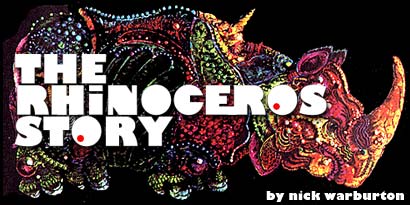 |
Revised and updated November 2002
New images added September 2011
|
During the heady days of the 1960's, Elektra Records was the hub of some of the era's most respected artists. Founded by Jac Holzman in New York in 1950, initially as a specialist in folk music, Elektra's full-scale move into rock coincided with the emergence of the West Coast scene. By the end of the '60's, artists like The Doors, Love, Tim Buckley and The Paul Butterfield Blues Band were producing records, which were garnering the label considerable respect.
A large part of this success was due to Holzman's skill in nurturing such talent, although it's true that he also greatly benefited from a gifted bunch of producers and engineers, including the late Paul Rothchild. Rothchild (the son of a British businessman and an East Coast opera singer) had made a name for himself as The Doors' producer and as a result was given the latitude to pursue his own projects. The most ambitious of these was undoubtedly Rhinoceros, an ad-hoc assembly of talented musicians, who Rothchild initially dubbed 'Supergroup'.
Although much of the credit for 'Supergroup' has been attributed to Rothchild, the role of his musical associate, producer Barry Friedman (better known as Frazier Mohawk) was equally important during the group's early days. Mohawk was an intriguing character who'd been instrumental, among other things, in helping Steve Stills piece together The Buffalo Springfield. When Rothchild pitched the idea of forming a band (comprised of his favourite players) in the spring of 1967, Mohawk was fresh from production work on the debut album of one of LA's most promising outfits, the eclectic Kaleidoscope.
Perhaps the versatility of that band and his earlier experience with The Buffalo Springfield were the underlying inspiration behind the 'Supergroup' concept. Whatever the reason, Mohawk was certainly responsible for the name and in late summer, he assisted Rothchild by approaching potential 'Supergroup' players. Both had particular musicians in mind, many of whom were invited to the "first formal assembly" at Rothchild and Mohawk's Laurel Canyon home on Ridpath sometime during September.
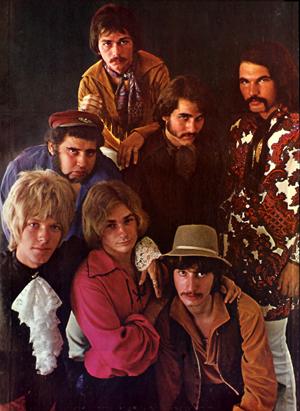
Among those chosen was recently fired Buffalo Springfield lead guitarist and ex-Daily Flash member Doug Hastings (b. June 21, 1946, Los Angeles, USA), who'd been asked to attend after an audition with Elektra band, Clear Light (featuring future CSN&Y drummer Dallas Taylor), had failed to secure a job. Though Clear Light were perhaps best known for their double drumming, Hastings felt that this novelty lay at the heart of his problem with the group: "I found two drummers playing the same thing in approximately the same tempo to be a nightmarish experience." Despite the brief setback, Hastings was not surprised by Rothchild's invitation, as (Paul) had "mentioned it to me in late summer 1967", presumably prior to the Clear Light audition.
Also present that day was Hastings' former colleague from The Daily Flash, drummer Jon Keliehor and former Kingsmen bass player Kerry Magness, both of whom had recently been working in a local group called Gentle Soul with singers Pam Polland and Rick Stanley. Hastings also remembers future Don Henley sideman Danny Kortchmar "flirting around the edges of the concept, but he didn't buy into it."
Rothchild and Mohawk however, were far from satisfied by their initial attempts to form 'Supergroup' and, according to Hastings, continued "to work the problem" for the next few months but without his involvement.
While Hastings temporarily dropped out (to play some final dates with The Daily Flash), Rothchild headed to New York and in early November recruited the services of Canadian bass player Peter Hodgson (b. Apr. 16, 1946, Toronto, Canada), currently playing in the house band at Steve Paul's famous club, The Scene.
Hodgson was already a seasoned musician when Rothchild's offer came through. During the early to mid-'60's, he'd played in (arguably) Toronto's finest R&B band - Jon and Lee and The Checkmates (they'd been offered a recording deal by Rothchild in late 1965 but turned it down). However, following the minor success of a lone 45, the soulful 'Bring It Down Front' (credited to The Jon-Lee Group), the band's two lead singers - Lee Jackson and John Finley - had left the band in Philadelphia and the remaining quartet headed to New York to play at The Scene.
Jon and Lee and The Checkmates had already caused something of a stir at the club earlier in the summer and so it didn't take long for the group to become the club's house band. Almost immediately, future Blood, Sweat & Tears vocalist David Clayton-Thomas enlisted the outfit's services and it briefly became his new support group, The Phoenix. Thomas however, was soon deported for being an illegal immigrant and work for the group began to dry up. Hodgson's immediate future was thrown into doubt until Rothchild happened to catch one of the group's final sets.
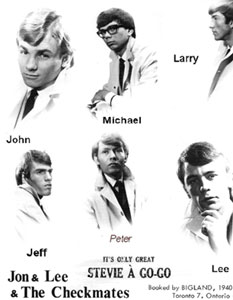 |
John Lee and the Checkmates poster for a gig in Toronto.
Courtesy of Craig Webb |
For Hodgson, the offer to join 'Supergroup' came at a fortuitous moment; in the aftermath of Thomas' departure, the group's keyboard player, Michael Fonfara, had been offered a place in The Electric Flag, while guitarist Larry Leishman and drummer Jeff Cutler were also interested in doing something new. (Cutler would later briefly join The Crazy World of Arthur Brown during its second US tour).
Hodgson wasted no time in accepting Rothchild's offer and immediately suggested his cousin, John Finley (b. May 6, 1945, Toronto, Canada) as lead singer for the project. Finley, who'd remained in Philadelphia for a few weeks after The Checkmates' split, was back in Toronto by then and remembers accepting Rothchild's offer to attend auditions after calling him collect from a phone box on Avenue Road. Gifted with a stunning voice, reflecting soul and gospel influences, Finley was an excellent choice and would ultimately become the band's focal point.
On November 30, Finley and Hodgson arrived at the Laurel Canyon house and were joined by around 30 other musicians, including Hastings, for the first initial auditions.
One of the other lucky hopefuls during this early stage was singer/songwriter and pianist Alan Gerber (b. May 27, 1947, Chicago, USA), who'd been singled out in advance by Rothchild following a fortuitous meeting in New York earlier in the year. At the time, Gerber was studying at Chicago's Roosevelt University, where he was majoring in composition and was a student of classical piano. A promising songwriter, Gerber had the unique distinction of having recorded a one-off single, 'It's You I'm Thinking Of/Love In Her Eyes', for a subsidiary of Chicago's Chess label when he was only 15 years old. Offered the choice of a solo contract or a position in the new band project, Gerber opted for the latter and gave up his studies.
Over the next couple of weeks, Rothchild and Mohawk arranged a series of rehearsals (initially on the top floor of a music store on Santa Monica Boulevard), so that the musicians could "jam in shifts". The rehearsals gave Rothchild the opportunity to listen to the musicians interact, and ultimately led him to discourage some people and bring in others. As the rehearsals proceeded, a fiery lead guitarist called Danny Weis (b. Sept. 24, 1948, Huntington Park, California, USA) turned up one day and immediately made his presence felt.
The young Danny Weis had become something of a minor legend in southern California by the autumn of 1967. As the leading light in the original Iron Butterfly, he'd attracted the patronage of several musicians, notably The Byrds' David Crosby, who duly recommended him for Al Kooper's new band, soon to become Blood, Sweat & Tears. Weis kindly declined Kooper's offer but his days with Iron Butterfly were numbered, and following a management dispute, he left the group to briefly play with the aforementioned Gentle Soul alongside Keliehor and Magness. (Hastings incidentally, replaced Weis for one show at a club on Sunset Boulevard around this time, before Erik Braunn joined as a full-time replacement.)
Weis' father had been a country and western swing guitarist who'd played with Spade Cooley and Tex Williams, and his son was fast proving to be an equally talented musician. In fact, besides John Finley, Danny Weis was undoubtedly the band's star performer, a fact that would lead to rivalry between the two musicians and play a part in Rhinoceros' ultimate demise.

Around the same time that Weis joined in the rehearsals, the project saw the addition of yet another former Jon and Lee and The Checkmates member, classically trained keyboard player Michael Fonfara (b. Aug. 11, 1946, Stevensville, near Niagara Falls, Ontario, Canada).
Fonfara had kept busy since parting company with Hodgson in New York. For a month or so he'd recorded and toured with The Electric Flag but after arriving in Los Angeles, he was busted for smoking dope and given the elbow by the group's manager, Albert Grossman. As fate would have it though, he ran into Finley and Hodgson at the Tropicana Motel (which is where the musicians were staying during the rehearsals) and was immediately added to the line-up.
A few days later, some of the 'lucky few' went up into the hills outside LA to drop acid - the rationale being that the experience would create a 'spiritual bond' within the band - but Magness was not impressed and quit in disgust. As a result, Hodgson was offered the bass spot in the band - alongside a line-up that now consisted of Finley, Fonfara, Gerber, Hastings and Weis.
As Christmas drew closer, Rothchild and Mohawk decided to put the project on hold; Gerber had arranged to visit Denver for the holidays, while Finley and Hodgson had the less appealing task of securing American work papers. On December 19, Finley and Hodgson headed back to Toronto to arrange their documentation while the others continued to rehearse on and off.
During this brief hiatus, Weis introduced his former Iron Butterfly cohort Jerry 'The Bear' Penrod (b. 25 Sept. 1946, San Diego, US), who so impressed Rothchild and Mohawk, that they contacted Hodgson (who'd also tried out for Ars Nova during his LA trip) and told him that his services were no longer required. With Penrod aboard, Fonfara, Hastings and Weis, together with Jon Keliehor were hired to back one of Elektra's recent signings.
Producer David Anderle had recently bagged a recording deal for his old friend, the late singer/songwriter David Ackles, who was in need of a support band to provide instrumental backing to his songs. The Ackles sessions were, as Hastings recalls, "presented as an opportunity to play together and make a little money" and proved to be a great success; the resulting album, released in October 1968, demonstrates the potential of the group project, despite the members' short time together.
With the Ackles experience behind it, the band underwent its final change in personnel in early March. Keliehor, like many of the attendees at the audition, had been unhappy with the brutal culling process that the group had been through and had dropped out after the first day's rehearsal (he subsequently rejoined Magness in the group Bodine). While he'd been available and willing to play the Ackles session, the group still required a full-time drummer to complete the line up. Enter top session player Billy Mundi (b. Sept. 25, 1942, San Francisco, USA).
A former Hell's Angel from East Los Angeles, Mundi was unquestionably a musician with serious credentials. A seasoned player, his career dated back to the late '50's, when he majored in music at UCLA. After graduation, Mundi worked for three months as a tympanist in the Los Angeles Philharmonic before moving into studio work and a succession of local bands.
Mundi spent the best part of the early '60's in future Byrd Skip Battin's group, Skip and The Flips, who recorded a handful of singles between 1963-1965. From there he enjoyed even shorter spells with folk-rock groups Mastin & Brewer and The Lamp of Childhood, plus a guest appearance on Tim Buckley's debut album among others, before Frank Zappa poached him for The Mothers of Invention in October 1966.
|
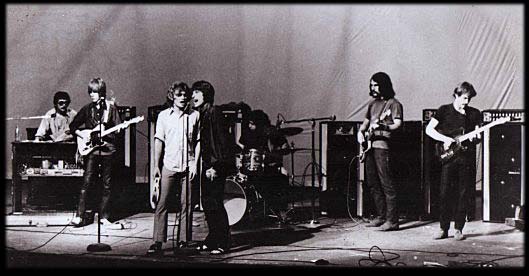
Rhinoceros on Stage (1968)
Left to right: Michael Fonfara(organ), Danny Weis(gtr), John Finley(vcl), Alan Gerber(vcl), Billy Mundi (drms), Jerry Penrod(bass), Doug Hastings(gtr). - picture courtesy of Billy Mundi.
|
Mundi became an integral part of The Mothers' line-up and is featured on the classic albums, 'Absolutely Free' and 'We're Only In It For The Money'. Eventually however, he became disillusioned by the band's financial plight and, living in dreadful conditions in New York's Chelsea Hotel, was ready to jump ship by December 1967. As Mundi recalls: "I was on a short break from the Mothers and went to New York to speak to Jac Holzman. He wanted me to check out a group of musicians that Elektra had corralled together to do something... I told him I had a few more dates to do and would fly out to LA and see. I did and I stayed. I began rehearsing and joined."
With Mundi onboard and Finley back in LA after securing his work papers, Elektra arranged rehearsals in a local studio, where according to Hastings, the septet finally "sounded like a real band." Elektra was suitably impressed by the new line-up and promised much. As Hastings recalls: "We were paid to rehearse and record, an unheard of arrangement for the time. We wouldn't have to make a dime, much less a profit, until after the first album release." Some sources reckon that Elektra invested as much as $80,000 in the band, a considerable sum of money for the time. Unfortunately, Elektra not only provided the financial muscle to support the group, they also hyped the band's credentials to the music press, something which would come back to haunt the group in the future.
Finley commented on this in an interview with Larry LeBlanc in the Canadian magazine Egg in late 1969. [Elektra] "didn't call us Supergroup! They called us 'project supergroup' - their concept of all their favourite musicians." [Elektra] "had this multi-thousand dollar campaign to make us instant mini-rock stars - you just go through a change, but by living together and jamming together the hype goes away."
The best part of early 1968 was spent preparing and practising material in Las Palmas Theatre in Hollywood, which was used by The Fantasticks at night. Then, in early June, the band was brought into Elektra's spanking new studios on La Cienaga Boulevard to work with engineer John Haeny (and Rothchild as a producer), and proceeded to lay down enough material for its debut album over a period of eight days. The group later returned during July to complete the sessions.
From the start it was clear that Rhinoceros had honed a highly original and well-crafted act despite their short time together. Not only that but the band had taken a bold move by recording the entire album in live takes, no mean feat, as most bands at the time were doing overdubs on all of their albums.
Danny Weis discussed this point with John Mars in Blitz magazine in 1980: "At the time, all the big groups like Cream and The Jimi Hendrix Experience were doing overdubs on all their things with something like nine guitars floating back and forth across the speakers on each track. I was the first in Rhinoceros to want to try for a live sound with all the advantages of the studio. Michael Fonfara thought it was a good idea too, and later all the other guys thought it was a good bet. The way we knew our stuff then, it just made sense to play like that."
According to Hastings however, the sessions did not run smoothly. As he recalls: "The seeds of our ultimate demise were sown here as we strongly disagreed over how to mix the album." That may be so, but it is not a sentiment shared by everyone, a fact that Hastings himself openly admits. "It was a minority view held mainly by Billy, Jerry and me, that the mix could be better… but we ultimately deferred to Paul - after all, how many hit records had we produced?."
Whatever the differences of opinion, Rothchild had the final say. Besides, as Hastings notes, the Haeny mix was a one-off "for us to listen to the completed tracks" and "was never captured on tape", to his knowledge. (Hastings however, treasures the 'scratchy' acetate of what he considers to be Haeny's "better mix.")
As the sessions were drawing to a close, it was decided that a name change was in order; 'Supergroup' seemed too presumptuous and after careful thought, the group decided to adopt Rhinoceros (apparently it was Gerber's favourite animal) over Rothchild's preference, MACH7. Finley later explained the group's choice to rock journalist Sara Davidson in her article, 'Rock Style - Defying The American Dream': "We listened to the tapes and they sounded just like a rhinoceros. The bass and the drums sounded lumbering and fat."
With the album in the can, Elektra hastily arranged some live dates and in mid-June, the band's debut performance took place at the Kaleidoscope (later the Aquarius Theatre). (The club was unique as it had a revolving stage, which would rotate as the next act was introduced.) The show was reasonably successful, enough so in fact to land the group some important support slots over the next few months, opening for the likes of Big Brother & The Holding Company, Three Dog Night and Taj Mahal, as well as label mates, Love.
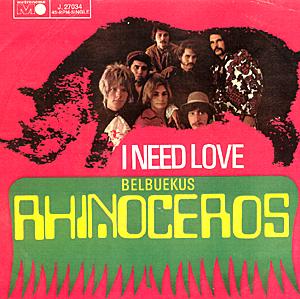 |
European Cover
I Need Love/Belbuekus
|
|
Japanese cover
Apricot Brandy/I Will Serenade You |
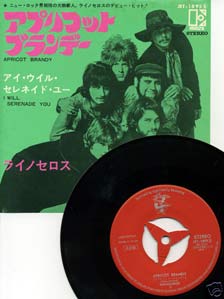 |
Rhinoceros in fact briefly became the house band at the Kaleidoscope and on one memorable occasion shared the bill with The Crazy World of Arthur Brown. As Hodgson (back in LA and working with Jackson Browne) recalls, during Brown's set, organist Vincent Crane tried to strangle the band's drummer (former Checkmates member Jeff Cutler), who responded by punching Crane in the face. The crowd, believing that it was all part of the act, responded by applauding the band's performance! (In an interesting side note, the good relations struck up between some of the members of the two groups would later result in Crane naming his band The Atomic Rooster after one of Rhinoceros' members.)
Meanwhile, Rhinoceros' reputation was beginning to spread beyond LA. Advanced tapes sent across the country to the press and to radio VIPs resulted in a flurry of activity that bode well for the future. Billboard magazine remarked that "the talent is so abundant, it doesn't have to be flashed to be evident", while Rolling Stone found that "tapes from Los Angeles on a new group, Rhinoceros, are enough to advise you to watch out."
Perhaps in anticipation of the assault on the East Coast, Rhinoceros relocated to the Big Apple in early September and were immediately put up in the infamous Chelsea Hotel, where the group stayed for three months. Elektra also bought the band a small amount of equipment to rehearse with and a few weeks later Rhinoceros' New York debut took place with a weeklong residence at the Café Au Go Go as the headlining act. Interestingly, the group's set list included Gerber's 'It's A Sin To Take A Life, (But Girl You've Taken Mine)', which had been left off the group's recently recorded album.
Then on the afternoon of the band's penultimate show, the group made its first prestigious appearance, at a free concert in Central Park before an estimated 12, 000 people. Also on the bill were visiting British dignitaries Traffic and Spooky Tooth, as well as the little known Wind In The Willows (featuring future Blondie singer Debbie Harry). The show was well received and led to further dates at the Café Au Go Go, with singer-songwriter Tim Hardin and John Lee Hooker in support. Billboard's Fred Kirby was a witness and was enthused by the band's performance: "Rhinoceros has a bright future, one that should reach the top ranks."
In mid-October, Rhinoceros made their debut appearance at Steve Paul's The Scene. Their three-day stand appears to have been an eventful experience as Hastings recalls: "The Brooklyn Hitters showed up one night to have it out with the doorman, who'd apparently thrown one of them out. Seven or eight of them beat up the doorman and then came in looking for trouble." The band was forced to retreat into the office at the back of the club with beer bottles in case things got nasty, but in the end the baseball players left without involving the group. Not surprisingly it was the end of that night's show.
The disturbances at The Scene appear to have gone unnoticed by the critics, who generally were full of praise for the band. Cash Box, which reviewed one of the first shows, wrote: "It's very seldom that we hear a group good enough, inventive enough, impressive enough to make us forget about being critics and make us start being an audience instead." [They] "have all the ingredients to be the top rock group find of 1968…and there is little doubt in our minds that as of now they are heavy contenders."
Not everyone however adhered to this view. Critic Annie Fisher, writing in the Village Voice, had witnessed the group's Café Au Go Go and Central Park shows and was not impressed by the hype surrounding the band. Like many sceptics, she believed Rhinoceros' up and coming dates at Bill Graham's Fillmore East would be the real "moment of truth".
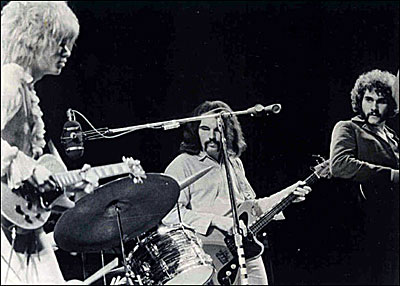 |
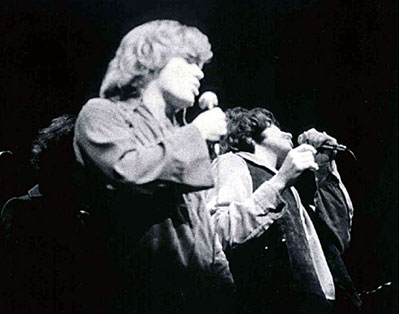 |
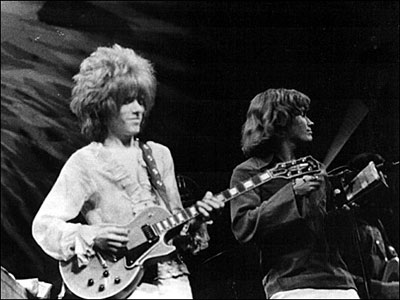 |
Pictures Courtesy of Michael Landskroner
from The Filmore East, October 25/26 1968.
Top: Danny Weis, Billy Mundi (Hidden),
Jerry Penrod, Doug Hastings
Middle: John Finley, Alan Gerber
Bottom: Danny Weis, John Finley
|
|
That appearance took place a few weeks later on the weekend of October 25-26, with the group opening for British bands The Moody Blues and John Mayall's Blues Breakers. The show went reasonably well, although predictably The Moody Blues garnered most of the press' praise. Rhinoceros meanwhile earned a second residence at The Scene, before a brief set of Toronto dates were hurriedly arranged to coincide with the release of their debut album.
Issued that November, 'Rhinoceros' highlights, above all, the strength of John Finley's gospel-inspired vocals, the songwriting skills of Alan Gerber, and the 'monster' playing of the band's rhythm section.
The critical response to Rhinoceros' debut album was decidedly mixed, however. Ellen Sander, who'd been fortunate enough to hear a test pressing of the album prior to its release, wrote a positively beaming piece for the Saturday Review in November, entitled 'A Question Of Values'. In it, she favourably compared the group to The Band, arguing that Rhinoceros were "a much needed shot in the musical alter ego of progressive rock." Like The Band, the group had "developed their musical identity… in a deliberately imposed semi-vacuum, so as not to be affected by any current trends."
Billboard likewise ran a positive review: [The group] "has an exceptional debut album that should spell success. Two strong lead vocalists plus excellent musicianship contribute to the effort." Canada's RPM magazine meanwhile went as far as saying, "we can only agree that Rhinoceros have acquired that something that could quite conceivably be the missing link to bring life back into the record industry."
Peter Applebome, writing in Rolling Stone the following January after the album's release, was less impressed, but still acknowledged the potential of the group as well as its originality. Rhinoceros "comes across as a talented unpretentious group, reminiscent of the late, great Buffalo Springfield. Tastefulness and restraint… mark most songs in contrast to most new groups."
Comparisons with both groups were useful, although not entirely helpful; Rhinoceros certainly contained an abundance of musical talent, but unlike The Band and The Buffalo Springfield, they struggled to win media approval, no doubt due to Elektra's publicity campaign, and consequently were never taken that seriously.
That is not to say that the album, which mixes "hard white rhythm 'n blues, with country, funk and gospel influences", doesn't have its merits. Among the highlights are Gerber's wistful 'That Time Of The Year' and Finley's plaintive ballad 'I Will Serenade You', which later became a top 20 hit when Three Dog Night covered it in 1973. The former is one of the best songs the group recorded and is a perfect example of Gerber's lyrical songwriting. The song also highlights the power and beauty of Finley's voice, leading Applebome to comment "John Finley's vocal here is the best on the album." Yet unlike Sandler, he was not completely endeared to the group's distinctive vocals and was also sceptical of the band's instrumental work.
Gerber's 'Along Comes Tomorrow' is a case in point. As Applebome argues, the track "begins as a very pretty song with some exquisite, crystal clear guitar work. Gradually the volume mounts until we are left with Gerber and Finley trying to out-shout each other on the chorus, ruining the song's unity."
Applebome also levelled criticism at the group's instrumental work: "Solos, especially Weis' guitar are generally excellent, but short and infrequent" and "some songs appear to be too tightly structured", in particular the band's signature tune, the Weis-Fonfara instrumental 'Apricot Brandy'. For a group tentatively dubbed 'Supergroup', this was inexcusable and Applebome was quick to make this plain: "Rhinoceros has got too many good musicians to put out an instrumental devoid of improvisations."
While some of the members had shown dissatisfaction with Rothchild's mix, there were apparently other differences, notably over the choice of material. It appears that several of Alan Gerber's best songs never made the final play list. These included the popular live numbers 'It's A Sin To Take A Life (But Girl You've Taken Mine)', 'Once Again' and 'Nothing To Say'. Furthermore, other songs such as the excellent 'Fine Day', which Hastings feels was the band's "best shot at a hit", may never have been captured on tape!
Despite Applebome's rather harsh criticism (and it's interesting to note that the same magazine did a similar demolition job on Neil Young's 'After The Goldrush', now considered to be one of rock's classic albums), he does at least acknowledge that "Rhinoceros is still a very new group" which "shows potential that could lead to a much better second album". Intentional or not, it is the most prophetic remark he makes. The group was unquestionably talented, but its potential would never be fully realised and the much-needed "better second album" never did materialise.
To lay the blame solely at Rolling Stone's feet may be unfair. And yet, even though rock criticism was still in its infancy, there were signs that the public was becoming increasingly swayed by such remarks and consequently it's possible the album suffered as a result. When the album peaked at a desultory #115, cracks in the group were inevitable.
The first casualty was bass player Jerry Penrod, who left abruptly after a date at The Scene (incidentally, two weeks after the Rolling Stone publication). Ironically, Rhinoceros' fortunes were on the ascent at the time and they were beginning to win over some of their initial sceptics. Jennifer Gale, writing in New York's Village Voice, wrote of Penrod's final show: "Rhinoceros has matured greatly in the few months they've been away from the city. Their music is more together and they've lost a lot of that plastic Sunset Strip bullshit."
Though Rolling Stone magazine may indeed have influenced the public's reaction to the album, it appears that internal problems had contributed to Penrod's abrupt exit - over the last few months, he'd reportedly suffered from increasing fits of despair. According to Finley, Penrod's departure was hastened by the run-ins between the singer and Danny Weis, which appear to have borne some resemblance to the rivalry between Stephen Stills and Neil Young in The Buffalo Springfield.
As Finley recalls, the band was playing at a college in Long Island and during the first set, an altercation took place between the singer and guitarist, which so incensed the bass player that he disappeared during the intermission. (In fact Penrod ended up walking all the way back to downtown New York with his bass leaving the band to complete the second set without him).
Penrod, somewhat surprisingly, rejoined the band at Steve Paul's The Scene a few days later, but after the first night it's believed that he experienced a bad acid trip and was checked into Bellevue hospital (not incidentally, at the same time as Moby Grape's Skip Spence). After a few days, Penrod discharged himself and duly returned to LA where he went on to do session work for Frazier Mohawk's wife Essra. Following a brief sojourn with the ill-fated Flintwhistle - the band formed by Weis' replacement in Iron Butterfly, Erik Braunn in 1970, he subsequently traded in a musical career to become a bus driver in his native San Diego.
Penrod's initial replacement was Danny's 17-year-old brother Steve (an equipment manager for the group), but he didn't have the musical credentials to be anything other than a stopgap.
The same month that Penrod left Rhinoceros, the group made the almost unanimous decision to fire Paul Rothchild as producer (only a few days before a scheduled initial pre-production meeting with Rothchild at Elektra's New York headquarters). Looking back, Finley believes that this fateful decision, combined with the move away from LA and the label's hyping of the band, was key to Rhinoceros' eventual downfall.
"One of the biggest mistakes was leaving the West Coast to go to the East Coast," says Finley. "Now that's no disrespect to the East Coast, but we were a West Coast band, we were started there and the label was there, what nurtured us was there. We also went to New York on a big hype and that was a mistake. You could hype in LA but not in New York. The other big mistake was firing Paul Rothchild. All the guys wanted him out except me."
Despite his misgiving about firing Rothchild, Finley opted to remain with the band and the new Rhinoceros line-up set out on the road. In early February, the band made its second appearance at the Fillmore East, supporting blues group Canned Heat and British folk-rockers Pentangle. The show appears to have received very little press but the positive reception that Rhinoceros was beginning to receive at concerts in general gave the new line-up the confidence to begin work on a follow-up album.
Shortly after a memorable appearance at the Boston Pop Festival, the band returned to LA to begin sessions for a second album with new producer David Anderle but immediately ran into problems in the studio with Steve Weis. Danny's brother was asked to leave and Peter Hodgson was flown in from Las Vegas.
Hodgson had kept himself busy following his abrupt exit in late 1967. After playing in David Clayton-Thomas' group The Combine (who recorded the original version of 'Spinning Wheel'), Hodgson relocated to Los Angeles in mid-1968 and played with Jackson Browne's Paxton Ranch band, (appearing on Browne's unissued debut album, 'Baby Browning'). When the Paxton project collapsed, he was recruited to play sessions for Elektra duo, Bamboo.
With Hodgson gradually immersing himself back into the fold, sessions resumed with David Anderle at the helm. Unfortunately, while Anderle's earlier collaboration with some of the musicians had borne fruit, the circumstances surrounding the current sessions meant that the band failed to build on the success of the David Ackles album, and more importantly Rhinoceros' own debut set.
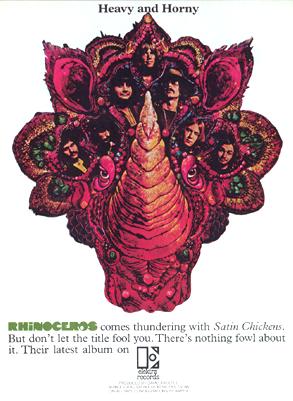 |
Promotional advert from Billboard magazine for the second album album, "Satin Chickens":
Courtesy of Dennis Kelley. |
Once again Gerber was frustrated by the fact that some of his best material was failing to be chosen, and indeed, the resulting album, 'Satin Chickens', reflects a more democratic approach to the song writing.
Fonfara now admits that there were difficulties producing the sound the band wanted and as a result the album lacks the cohesion and focus of the first. The absence of Paul Rothchild arguably may have played a part in the proceedings.
In fact, as Finley points out, the resulting album is far removed from the original concept as devised by Rothchild. "It was going to be an album of singles," says Finley. While the actual track listing was never finalised, Finley says that it would most likely have included original material like Gerber's 'It's The Same Thing', but in a radically different form. "'It's The Same Thing…would have been recorded at a faster tempo, so it would have been more like soul music," says Finley. "Paul was going for singles. He was also going to get outside originals, real R&B, soul songs and then, two or three covers in addition to the internally generated material. Do original arrangements on covers. But the band fired him before he could tell us."
In the immediate future, the disappointment over 'Satin Chickens' didn't pose a serious problem. As the sessions were drawing to a close, the band enjoyed what would be its biggest hit when Weis and Fonfara's instrumental 'Apricot Brandy' peaked at #46 on the national Billboard charts. The song was subsequently adopted as a signature tune by British radio programmes 'What's New' and 'Scene and Heard', but somehow failed to chart in the UK, despite some air play. As the single began its descent, the band's management was taken over by Billy Fields and Sid Bernstein, who proceeded to secure more high profile live appearances in an attempt to plug the single.
In May, Rhinoceros embarked on a flurry of activity, the highlight of which was the group's performance at a WNEW-FM radio concert in Central Park on June 13 with BB King and others, where they attracted some 40, 000 people.
But in the long run, the group's live success did little to dispel the growing differences within the band. The failure to produce a strong second album and dwindling finances "fed antagonism" and according to Hastings, the result was best "documented in a Harper's article" which was published in July. (It's interesting to note that by the spring of that year, the band's debut album had only sold around 100,000 copies, not even half of the sales needed to write of the group's debt to Elektra.)
As Hodgson recalls, a management meeting was held in late June and to everyone's surprise, Hastings announced that he was leaving. He subsequently drove back to LA and hooked up with ex-Gentle Giant singer Pam Polland. According to Hastings the "first gig was in early fall at the Troubadour, but it was unimpressive, and after a couple of months we drifted apart".
Hastings' departure precipitated a general split in the group. Shortly after a memorable date at Flushing Meadows in New York in early August, both Alan Gerber and Billy Mundi also left to pursue new projects.
The departure of three of the group's original members appears to have been due to a combination of factors. To start with, the Canadian members of the band had voiced their interest in bringing The Checkmates' former guitarist Larry Leishman (b. Apr. 4, 1947, Dunfermline, Scotland) and ex-manager, Eddie 'Duke' Edwards (b. New Orleans, Louisiana, US) into the fold.
At the same time, the group's internal dynamics had been weakened both by "differences in opinion among band members" and the various run-ins between Finley and Weis. Perhaps most importantly, the fact that Paul Rothchild (the one person who'd been responsible for bringing the musicians together) was now out of the picture, meant that the there was no one to keep the group together. For these reasons bringing in the familiar faces of Edwards and Leishman made perfect sense.
Amid all this activity, Elektra released the group's long awaited second album, 'Satin Chickens', which contained some of the group's best work but was, overall, something of a disappointment.
Billboard magazine nevertheless remained loyal to the group's cause and was quick to support it: "Few rock groups are as equally adept at instrumental and vocal performances as Rhinoceros, and their skills continue in their latest album… John Finley's soulful vocals on 'Top of the Ladder' makes it the best cut."
The album's other highlights are Finley's brooding 'Don't Come Crying', which builds in intensity with each verse, and Gerber's swansong, the melancholic 'Find My Hand'. Weis also chips in with the sprightly 'Monkee Man', co-written with Finley, while Hastings' comical '(Get Out The) Back Door' was deemed commercial enough to be released as a single. However, it failed to capture the public's imagination and died a quick death. Ironically, 'Satin Chickens' proved to be the group's highest placed album, peaking at #105.
As 1970 dawned and with Rhinoceros starting afresh, the ex-members of the group began to surface in new projects. Following his brief stint with Pam Polland, Doug Hastings became a member of Dr John's support band and participated in a short autumn tour (alongside his ex-Daily Flash cohort, the late Don MacAllister). Besides the tour (which included an appearance at the Fillmore East in October 1969), Hastings contributed guitar to a few tracks on Dr John's album 'Remedies'. However, after returning to LA in November, he received a phone call from Frazier Mohawk, who brought him into the studios to work with his wife Essra. Interestingly, the sessions for Essra Mohawk's solo album 'Primordial Lovers', also reunited Hastings with Jerry Penrod.
Essra Mohawk, incidentally, had been one of the musicians that Paul Rothchild and Frazier Mohawk had singled out in advance when they first toyed with the 'Supergroup' concept. However, as Essra recalls, other commitments prevented her from ultimately joining the group. "I remember that they called me an asked me to be in the band when they were first putting it together. They'd already heard me so I was never asked to audition, just to join. I really wanted to join, especially since Billy Mundi had played in The Mothers with me and I loved the way he played back then. He quit The Mothers right after I did, but I was still signed to Frank [Zappa] and Herbie [Cohen] and they wouldn't let me join Rhinoceros. I've always regretted that."
The reunion between Hastings and Penrod was short-lived, however. Following sessions for ex-Cowsills singer/guitarist Bill Cowsill and David Ackles, Hastings subsequently hooked up with singer/songwriter Danny O'Keefe, an old acquaintance from Seattle. His understated guitar work can be heard on O'Keefe's excellent eponymous album, recorded during the early months of 1970, but not issued until the following year. By then Hastings had all but jacked in a career in rock music (he did briefly work with Seattle band Firefox during 1971-1972 playing cover material in local clubs). In the early '70's however, he returned to college and started a course, which has led to a career in petroleum geology.
Alan Gerber, who nearly remained with the group as a songwriter, subsequently won a solo deal with Leon Russell's Shelter label and travelled to Memphis, Tennessee to record 'Album' with producer Denny Cordell. The record (featuring stellar support from Fonfara and Weis) was released in 1971, but was not a great success (a fact which hasn't deterred the Japanese from issuing it on CD). After supporting Leon Russell on tour, Gerber moved to Montreal in the mid-'70's, and released a lone single, 'Tied On', backed by a cover of Edith Piaf's 'Milord' for the local Good Noise label. Shortly afterwards, Gerber briefly became involved with Bob Dylan's 'Rolling Thunder Revue' and two of his songs were subsequently used in his film 'Renaldo and Clara'.
Mundi meanwhile, found himself in demand as a session player and between late 1969-mid 1970, he contributed to a host of projects, including John & Beverly Martyn's 'Stormbringer', Bob Dylan's 'New Morning' and a one-off reunion with The Mothers of Invention at UCLA. In the early '70s, he kept himself busy playing sessions for the likes of Todd Rundgren, The Band and his old friend, Skip Battin from The Byrds. He also joined Brewer & Shipley's road band for a while and recorded with little known groups Razzmatazz and Borderline among others.
As mentioned earlier, the demise of the original band was due in part to the decision to replace some of the members with old friends Larry Leishman and Duke Edwards. Since December 1968, Rhinoceros had been living in Graymanse, a former summer estate of a marine welding executive in Lake Mahopac, New York, and Edwards and Leishman both remember a degree of friction when they moved in (Alan Gerber was still residing in the house and Billy Mundi was a close neighbour. The decision to bring in their old friends however, was understandable given that the group had lost a lot of its early momentum.
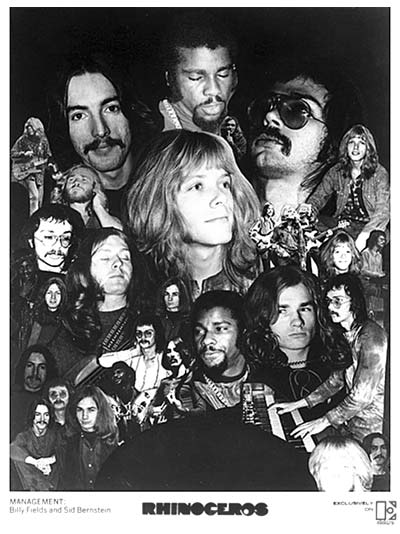 |
Rhinoceros Promotional Card, 1970.
Many thanks to Mike Somavilla and Jeff Watt for this. |
Edwards, whose role would be as drummer and to help with the songwriting now that Alan Gerber had moved on, appears to have played a major role in revitalising the band. Leishman's playing meanwhile was familiar to the other former Checkmates and brought much needed stability. Both had been active since The Checkmates had gone their separate ways.
After David Clayton-Thomas & The Phoenix broke up, Leishman had returned to Toronto, where he briefly gigged with several local groups, including Bobby Kris & The Imperials and Freedom Fair (subsequently known as The Power Project). The latter incidentally also included ex-Mandala and future Crowbar keyboard player Josef Chirowski, and one of the band's most memorable dates was opening for James Brown in Toronto in mid-1968. Towards the end of the year however, Leishman hooked up with Duke Edwards in his new band The Cycle.
Edwards is a real character with a history to match. Following a stint in the US army, Edwards spent three years studying at the Boston Conservatory of Music. When he graduated in 1961, he joined the Chitlin circuit, which took him to Montreal, and while there met jazz musician Sun Ra, with whom he played for two years.
A short while later, Edwards met booking agent, the late Ron Scribner and together they formed the music agency, 'Music Canada', with Scribner responsible for the bookings and Edwards running the road shows. Scribner introduced Edwards to Jon and Lee and The Checkmates, and together they spent the next four years honing the group's act and organising TV work and concert dates in Ontario and the northeastern states of the US. Edwards also produced some recordings in a studio on Queen Street in Toronto, which led to some TV appearances in Buffalo and New York. Later, he was credited for the b-side of The Checkmates' lone single, the instrumental, 'Pork Chops' which, incidentally, was provisionally titled 'Fuck Up'.
In mid-1967, Edwards left The Checkmates and returned to Montreal to work as the musical director for the World Fair. (Scribner, who reportedly had encouraged Paul Rothchild to come to Toronto to check out The Checkmates back in November 1965, continued to promote local talent, but through his efforts should be given some credit for the birth of Rhinoceros.)
When the World Fair finished, Edwards formed The Young Ones, an all black avant garde jazz band who wore flamboyant Egyptian robes on stage and espoused radical political ideas. Apparently their 'Touch of Black' revue, performed at Montreal's Le Club for 14 weeks, caused quite a stir and led to an album deal with Prestige Records.
As Edwards recalls, the label recorded around three albums' worth of material but in the event only a lone album, entitled, 'Introducing Duke Edwards & The Young Ones - Is It Too Late?' appeared. The fact that Edwards had only signed a one-year contract with Prestige, which incidentally didn't include the band, meant that The Young Ones project was never likely to last for long. Furthermore, when the album was released, the band found that its music had attracted the interest of radical elements in Detroit's black community, and Edwards decided to kill the project and move on.
After separating from The Young Ones in late 1968, Edwards formed the less controversial Duke Edwards Cycle, a trio, which besides Edwards and Leishman, also featured future John Hammond bass player Herman Pittman. The group quickly attracted the attention of Polydor Records, who offered the band a contract worth $10,000. However, at this point Rhinoceros' manager Sid Bernstein arrived on the scene with an invitation to join the band. Though the offer to join Rhinoceros was subsequently taken up, Edwards still feels a degree of guilt that Herman Pittman was left out of the arrangement, particularly as he'd given up everything (including his marriage) to join The Cycle.
With Edwards and Leishman added to the line-up, the group missed out on arguably the greatest opportunity of its career, the chance to appear at the decade's seminal rock music event - the Woodstock festival.
Apparently, Rhinoceros were friends with the organisers and had been offered a provisional slot at the festival in advance. As fate would have it though, Sid Bernstein took the fateful decision to go on holiday at this crucial moment, leaving his junior partner, Billy Fields, with the strictest orders not to accept a booking at the festival below a given fee (an unfortunate decision given that the festival organisers were not paying very much).
In the ensuing drama, Fields declined the festival's offer and booked the band at an upstate New York high school prom instead. To add insult to injury, he booked Rhinoceros' support band Sha Na Na in their place and as Fonfara points out, the following week Rhinoceros were Sha Na Na's support group! The band was naturally devastated but spent the best part of late 1969 honing its act and incorporating Edwards and Leishman's material from The Cycle.
Unfortunately, the new recruits arrival was not particularly well-timed as sessions for a third album had already been hastily arranged at A&R Recording studios in New York in the early months of 1970 and, as Fonfara admits, the group's new songs were not ready in time.
To compound matters, the group's new producer, Guy Draper, seemed more interested in using the group as a vehicle for his own song writing and the overall performance suffered as a result. Another criticism is Edwards' dominance in the song writing stakes and lead vocals, which led to the diminished role of Finley and his trademark voice.
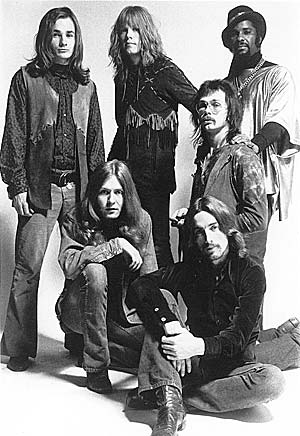 |
Elektra promotional picture around the time of the third album, "Better Times Are Coming".
Clockwise from top centre, Danny Weis, Duke Edwards, Michael Fonfara, Larry Leishman, Peter Hodgson and John Finley.
Picture courtesy of Jeff Watt - www.legacylinks.com |
Single sleeve for the French release of Let's Party / Old Age.
Picture courtesy of Denis Kelley. |
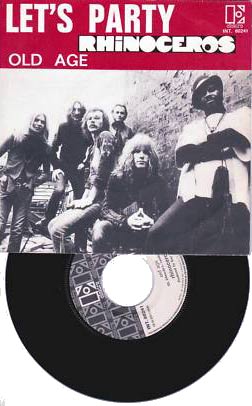 |
While 'Better Times Are Coming', like its predecessor, failed to build on the success of the band's debut, it still has much to commend it. The album's title track, written by Edwards with Fonfara and Finley, is undoubtedly the album's highlight, and is Finley's single contribution, apart from a rather poor, if prophetic, collaboration with Weis entitled 'Somewhere', a left over from the debut album.
Of the others, the Edwards-Leishman collaboration 'Old Age', featuring a blistering instrumental passage, reflects the group's strength as a live act, while the elongated 'Rainchild', with its political overtures, is reminiscent of Edwards' work with The Young Ones. Equally fascinating is the Edwards-Leishman collaboration, 'Lady of Fortune' with its captivating funky rhythm patterns.
Draper's contributions meanwhile range from the instrumental 'Insanity', which roughly treads the same ground as 'Apricot Brandy' to the poppy 'It's A Groovy World' and the catchy sing along 'Let's Party', which was released as a single but failed to chart. The public was not impressed and the album stalled at a desultory #178 when it was released in July.
However, things weren't all that bad. If the group struggled to deliver the goods in the studio, they could still pull the crowds live, and during this period even made a cameo appearance in the rock film 'The Day The Music Died'.
Rhinoceros in 1970
Clockwise from top left: Larry Leishman,Peter Hodgson, Michael Fonfara, Danny Weis, John Finley,Duke Edwards.
Picture courtesy of Giannina Brown.
|
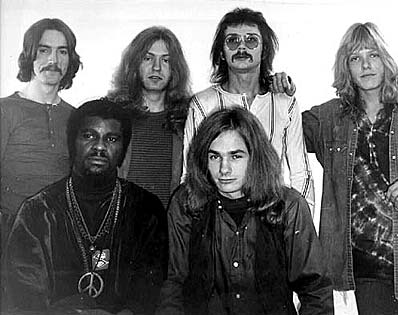
|
In April 1970, Rhinoceros joined Ten Wheel Drive for a well-received date at New York's Carnegie Hall and on June 12-13, performed one of their last major concerts, with a return to the Fillmore East alongside Procol Harum and Seals & Croft. The group was given positive reviews in the press but the rot had clearly set in and shortly after the single 'Better Times' peaked at #109 in late August, Edwards dropped out of the band.
As Edwards recalls: "I was getting kinda fed up with the whole trip, rock 'n' roll and the concerts and the shows. It was beginning to repeat itself." Coming from a jazz background, Edwards claims that he needed more substance in his life, and it was during the group's visit to Hollywood and New Mexico to shoot for the soundtrack of Warner Brothers' movie 'Medicine Ball Caravan', that he first entertained thoughts of leaving the band. During the shoot, Edwards ran into Wavy Gravy and the Woodstock road crew who were living in a mobile commune. Attracted by their political ideas, he immediately approached Bernstein about leaving Rhinoceros. The others meanwhile were left to return to upper state New York to recruit a suitable replacement.
Initially the band attempted to re-recruit Billy Mundi, who was doing session work at Bearsville studios. As Mundi recalls: [They] "came to visit Bearsville and talk to me about rejoining the band for some dates in Canada. I said maybe, if it made sense. We talked about it but it didn't work."
Next the band turned to Richard Crooks, who'd played alongside Doug Hastings on Dr John's autumn 1969 tour (and had also recently played on Danny O'Keefe's debut album!). Crooks played with Rhinoceros for the rest of the year but later moved on to play a host of sessions and a stint as Loudon Wainwright III's drummer. Around the same time, the group lost one of its key members when Danny Weis abruptly left Rhinoceros. Weis subsequently did sessions for an album by Ohio Knox, before replacing Buzzy Feiten in The Rascals.
Returning to Toronto, Crooks was replaced briefly by transplanted Englishman, Malcolm Tomlinson (b. June 16, 1946, Isleworth, Middlesex), who'd previously played with Jeff Curtis & The Flames, the house-band at the Ealing Jazz Club. Later, he worked with future Jethro Tull guitarist Martin Barre in the bands Motivation, The Penny Peeps and Gethsemane, and played on a one-off radio session for Elton John in October 1968.
Moving to Canada in early 1969, Tomlinson worked initially with the highly rated Toronto band Milkwood (with his old friend from The Flames, Louis McKelvey), before rehearsing with Rhinoceros in early 1971. Tomlinson however, broke his arm soon afterwards and was replaced by drummer Eric 'Mouse' Johnson (b. Virginia, US), a former member of local Toronto band, Dianne Brooks, Eric Mercury and The Soul Searchers. Johnson, who'd also been an original member of Dr Music, took over the drum stool for the band's final months.
The final version of the group based itself in Toronto and played exclusively in Ontario (Fonfara knew he could book consistent work for the band there) but it did not last long; in October 1971 the group members decided to call it a day and went their separate ways.
Most of the band dropped out of sight, at least temporarily, although Leishman did take part in Mainline's tour of Australia with Frijid Pink and Hodgson found work with Polish-born singer Genya Ravan (formerly lead singer in Ten Wheel Drive) in her backing group, Baby. After an eponymous album for CBS, released in the summer of 1972, Hodgson returned to Toronto to rejoin his former cohorts in a new band called Blackstone Rangers.
Blackstone Rangers (featuring Finley, Fonfara, Hodgson and Leishman from the final Rhinoceros line-up) came together in July 1972, with the help of Frazier Mohawk (now based in Canada) and his business partner, Gary Howsam. The group was completed with a new drummer, the late Richard Steinberg and the late singer and harp player Frank 'Zeke' Sheppard, who'd played with Leishman in Mainline (and reportedly opened for Otis Redding in Toronto back in October 1967 with his band The Good Sheppards). More importantly the new band saw the welcomed return of Danny Weis.

During this period, the group was forced to drop the Rangers tag after a Southside Chicago motorcycle gang and escort to the Black Panther's demanded that they shorten the name. Apparently the group had unwittingly adopted the bikers' name.
With a suitable collection of songs to record, Finley invited his old friend Paul Rothchild up to Toronto to produce the band, a wise move bearing in mind that the original Rhinoceros members had enjoyed their greatest success with Rothchild at the helm. A deal with GRT was arranged and an album entitled 'On The Line' was duly cut on two-track at Toronto's RCA Recording Studios in a bid to recoup some of the group's and Rothchild's financial losses with this latest project.
'On The Line' is no lost classic, but certainly contains some excellent songs, notably a cover of Dr John's 'Qualified', and the Weis-Steinberg collaboration 'Mountain'.
Canada's RPM magazine wrote an encouraging review of the album when it appeared that December. "Put 'On The Line' on the turn table and travel back in time. That staple of the old high school bands, the organ, makes a strong contribution to this set, fronted by forceful and varied vocal work. The group possesses obvious musical ability and could well break through."
Unfortunately, not all of the critical response was as complimentary. Larry LeBlanc writing in the Canadian magazine, Today's Generation in February 1973 wrote: "[Blackstone have wasted] their considerable talents on reworking fading musical forms. As usual the band's strength lies in its galvanizing, mesmerizing chorus; its weakness lies in trying to mime several minutes out of each melody."
LeBlanc continues: "There are two obvious idioms - rock-soul and country-blues. The old blues stand pretty much on their own (with the exception of Sam Cooke's haunting 'A Change Is Gonna Come' which has been built into a self-parody of do-wop), even for listeners who enjoy a note-for-note familiarity with the originals." Furthermore, "when the production style accentuates the hysterical, monomaniacal, and desperate side of their playing, as it does on 'Back Door Man', it becomes too much."
The album proved to be the group's swansong, as shortly after its release Blackstone effectively split into various factions. Fonfara and Weis did briefly keep the name going for a few months by recruiting ex-Bush members Prakash John and Penti 'Whitey' Glan and Californian singer Mike Stull (later in Bobby Krieger's Butts Band) but it didn't work out. The band relocated to LA and duly split into several camps. (Stull incidentally, later wrote the theme tune to Cagney and Lacey.)
In the aftermath, Fonfara and Weis kept busy as freelance musicians, while Prakash and Glan joined Lou Reed's road band. The following year, the quartet crossed paths and Fonfara and Weis were invited to appear on Lou Reed's album 'Sally Can't Dance'. Reed kept the group on for a European tour but soon afterwards, Prakash and Glan dropped out and Peter Hodgson and Eric 'Mouse' Johnson joined up for a year-long tour of Australia, New Zealand and the US. For Michael Fonfara, joining Lou Reed proved to be a fortuitous move as he spent the best part of the '70's leading Reed's support band.
Danny Weis meanwhile spent a brief period playing with Alice Cooper and Rick James' Stone City Band, before supporting ex-Guess Who singer Burton Cummings and acting as musical director to Bette Midler's 'Rose' band. During the early '90's he fronted the California group Funk Attack and currently leads his own outfit, The Danny Weis Project (he also keeps busy doing session and TV work). More importantly, he is planning his first CD, an R&B/funk album mixing covers and original material and provisionally entitled 'Danny Weis'. The rest of Blackstone maintained a much lower profile.
John Finley, who'd recorded a gospel album with Bill King's Homestead for Nimbus 9 Records in early 1972, and sung on Suzie Quatro's brother, Michael's album 'Paintings', subsequently moved to LA and dropped out of performing. During 1973, he enjoyed success when Three Dog Night took his rewritten Rhinoceros tune, "Let Me Serenade You" (orig. 'I Will Serenade You',) into the US top 20, and over the next few years, Finley started to concentrate more on studio work and song writing. During the late '70's, however, he worked with the Rev. James Cleveland and Alexander Hamilton & the Voices of Inspiration on the local soul/gospel choir scene. The latter incidentally, provided back up vocals on albums by Chicago and The Beach Boys.
In the early '90s, Finley enjoyed success again as a songwriter when Ivan Neville (Aaron Neville's son), covered a song he'd co-written called 'Why Can't I Fall In Love?' for the movie soundtrack 'Pump Up The Volume'. He is currently leading his own jazz/soul outfit, SOULBOP! who are in the process of recording a CD. This year, Finley also contributed vocals and piano to the NorthernBlues Gospel Allstars CD 'Saved' in Canada, which featured Michael Fonfara and was produced by Frazier Mohawk. The CD was issued in October to local acclaim.
Larry Leishman dropped out of the music industry to work for Motorola Canada Ltd., and currently runs his own business outside Toronto. He still does the occasional studio session plays live on the Toronto scene, and is shortly joining Finley, Fonfara and Hodgson for some local dates.
Peter Hodgson also remained active but kept a relatively low profile following the Lou Reed tour. During the mid-'70s he briefly played and recorded with Rick James. Following sessions for Toronto rock 'n' roll band Shooter, he briefly played and recorded with new wave group Rough Trade (alongside Michael Fonfara) and gigged with the Malcolm Tomlinson Band before retiring from the music business in 1980. He now works in the real estate industry in Toronto but like Leishman, Hodgson still plays on the Toronto scene.
In the late '70s, Steinberg moved to New York, where he formed Tycoon with Fonfara. Inspired by Toto, Tycoon proceeded to record two albums in 1979/1980, which met with a modicum of success but floundered on the indecision of the band's label. While recording with Tycoon in London, Fonfara landed a job with Foreigner and appeared on their album '4'. He then returned to Toronto and rejoined Weis in The Lincolns for a few years during the early-mid-'80s.
More recently, Fonfara has become an integral member of Toronto's premier Blues outfit, The Downchild Blues Band who have recorded a 30th anniversary album with help from old friend Dan Ackroyd and blues legend James Cotton. Besides winning numerous awards for work with The Downchild Blues Band, he also keeps himself busy gigging incessantly in the Toronto area, and has been involved in a wealth of production work for both local and international artists.
In 1999, Fonfara, Hodgson and Leishman reformed The Checkmates, and have been joined on various occasions by Finley whenever he is in town. The band is currently recording some tracks for a long overdue CD.
Checkmates associate Duke Edwards meanwhile heads the Louis Armstrong Foundation in New Orleans and works for the city government co-ordinating, among other things, cultural events with its sister city in Japan. He has been involved with the restoration of the Evergreen Plantation, the largest surviving plantation in the American south and has been responsible for writing the historical notes for visitors. Edwards, who recently turned 70, still maintains an interest in music and currently leads his own New Orleans jazz band.
Of the other original Rhinoceros members: Doug Hastings took part in a brief Daily Flash reunion with John Keliehor and Steve Lalor in 1994 and continues to work in petroleum geology in Alaska. He claims to jam on the guitar in his garage on a regular basis.
Alan Gerber meanwhile regularly performs at blues festivals in North America and has also lived and performed in France. Following a one off tour with Lou Reed in 1979, he has established a highly respected solo career and produced several solo CDs over the last few years. He is currently touring to support his new live album on the Mugwamp label.
After years of playing copious sessions Billy Mundi dropped out of performing and currently lives in Northern California. However, during late 2001, he joined former Mother of Invention members Don Preston, Roy Estrada and Bunk Gardner for a brief East Coast tour as The Grandmothers. He has also returned to the studios and in the last few months, joined Essra Mohawk to record a CD of women artists singing Doors songs in Nashville.

With all the group members' collective post-Rhinoceros accomplishments, the interest in a reunion, involving a possible album deal, may seem a forgone conclusion. Frazier Mohawk did in fact pitch such an idea a few years back, but although most of group was 'up for it', he was unable to find a financial backer. Were such a deal struck, there is also the small problem of getting everyone together; Doug Hastings, Billy Mundi and Jerry Penrod are leading different lives now, while the others have musical commitments to fulfil and different musical agendas to pursue.
While the recent release on CD of Rhinoceros' debut album by the Collectors Choice Music label is long overdue and extremely welcomed, it was slightly disappointing that no previously unreleased material was included, especially as around 15 tracks were originally cut for the record. The prospect of seeing any further releases will undoubtedly rest on the CD's sales. And yet, besides the group's remaining albums, there is a plethora of previously unreleased material to choose from, what with Hastings' rough acetate of 'Rhinoceros', outtakes from the various albums, and demos recorded with Todd Rundgren (Finley's 'Open Heart' and 'Sail On').
It remains to be seen then, whether any label will take the plunge and put together the much-anticipated box set that the group deserves. That wouldn't be asking too much for one of the '60's lesser-known but greatly cherished bands.

I have tried to ensure that this article is as accurate as possible. I do however, apologise for any historical inaccuracies that may exist and would be grateful to hear from anyone who can provide corrections and updates.
Sources:
Applebome, Peter. Rolling Stone, January 4, 1969.
Ballard, Barry. Omaha Rainbow #11, December 1976, pages 16-17.
Davidson, Sara. ‘Rock Style – Defying The American Dream’, Harper’s Magazine, July 1969, pages 53-62.
Einarson, John and Furay, Richie. For What It’s Worth - The Story of Buffalo Springfield. Quarry Music Press, 1997, page 85.
Fisher, Annie. Village Voice, October 3, 1968, page 30.
Gale, Jennifer. Village Voice, January 23, 1969, page 36.
Heibutski, Ralph. ‘The Flight of The Phoenix’ Goldmine Magazine #421, Sept. 13, 1996, pages 20-23.
Hounsome, Terry. Rock Record #6, Record Researchers Publications, 1994.
Housden, David Peter. The Castle - Love #2, July 1993, page 36 and The Castle - Love #9, December 1995, page 59.
Kirby, Fred. Billboard, October 12, 1968, page 12.
LeBlanc, Larry. ‘John Finley of Rhinoceros’, Egg, August/September 1969, page 16.
LeBlanc, Larry. Today’s Generation, February 1973, page 36.
Mars, John. ‘(Almost To The Top) Of The Ladder’, Blitz magazine, Number 37, July-August 1980.
Melhuish, Martin. Heart Of Gold - 30 Years of Canadian Pop Music. CBC Enterprises, Toronto, 1983, page 95.
Parles, Jon and Romanowski, Patricia, Rolling Stone’s Encyclopedia of Rock ‘N’ Roll, Rolling Stone/Fireside Books, 1983.
Rees, Dafydd and Crampton, Luke. Guinness Book of Rock Stars 1st Edition. Guinness Publishing Ltd, 1989, page 510.
Sander, Ellen. ‘A Question Of Values’ Saturday Review, November 30, 1968, page 80.
Skok, Neal and McMullen, Phil. ‘The Daily Flash’, Ptolemaic Terrascope #12, July 1992, pages 16-19.
Stambler, Irwin, Encyclopedia of Pop, Rock and Soul, St. James Press, London, 1974, pages 421-422 and 432.
Whitburn, Joel. Bubbling Under Hot 100 1959-1985. Billboard Researcher Inc, 1985.
Whitburn, Joel. Joel Whitburn’s Top Pop Albums 1955-1992. Record Research Inc, 1993.
Billboard:
September 28, 1968, page 68; December 21, 1968, page 56; May 3, 1969, page 14; May 24, 1969, page 20; May 31, 1969, pages 28 and 79; July 5, 1969, page 29; August 16, 1969, page 71; September 20, 1969, page 24; January 10, 1970, page 16; May 2, 1970, page 28 and August 29, 1970, page 18.
Revelation (Elektra’s Newsletter):
November, 1968, January-March 1969 and February 1970.
Rolling Stone:
May 31, 1969.
RPM:
RPM Weekly, November 2, 1968 and December 2, 1972.
Variety:
July 2, 1969 and December 31, 1969, page 41.
Village Voice:
September 19, 1968, page 45; October 24, 1968, page 43; January 16, 1969, page 33; February 6, 1969, page 30; March 6, 1969, page 34; May 8, 1969, page 36; June 5, 1969, page 27 and June 12, 1969, page 42.
Many thanks to the following people for their generous help: John Finley, Alan Gerber, Doug Hastings, Danny Weis, Michael Fonfara, Billy Mundi, John Haeny, Peter Hodgson, Larry Leishman, Duke Edwards, Frazier Mohawk, Essra Mohawk, Jon Keliehor, Danny Hannagan, Carny Corbett, Hugh MacLean, John Einarson and Bill Munson.
Many thanks to Dennis Kelley, Craig Webb and Randy Pratt of Star People and The
Lizards for pictures included with this article.
A Selected Discography to accompany this article is here.
Copyright © November 2002 Nicholas Warburton. nick_warburton@hotmail.com
 Nick Warburton is a freelance music journalist that has written a number of articles on Buffalo Springfield related groups. Among the bands he has covered are Rhinoceros.
Nick Warburton is a freelance music journalist that has written a number of articles on Buffalo Springfield related groups. Among the bands he has covered are Rhinoceros.
This article is a result of his extensive research, and he has kindly given permission for it to be posted on this site.
|

|

